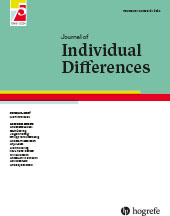Abstract
Abstract: We investigated, to what extent Conscientiousness can predict academic performance in a real application high-stakes setting. N = 267 applicants for a place at a university completed a Conscientiousness questionnaire during the selection process and 6 weeks after they commenced their studies. Students’ academic grades were used as criterion variables. The results suggest that the high-stakes setting increases the level of Conscientiousness reported, that not all applicants change their answers to the same extent and that the high-stakes setting decreases the criterion-related validity, but Conscientiousness remains a useful predictor for academic performance in high-stakes settings.
References
(2000). A meta-analytic investigation of the susceptibility of integrity tests to faking and coaching. Educational and Psychological Measurement, 60(1), 59–72. https://doi.org/10.1177/00131640021970367
(1996). Effects of impression management and self-deception on the predictive validity of personality constructs. Journal of Applied Psychology, 81(3), 261–272. https://doi.org/10.1037/0021-9010.81.3.261
(2001). Personality and performance at the beginning of the new millennium: What do we know and where do we go next? International Journal of Selection and Assessment, 9(1–2), 9–30. https://doi.org/10.1111/1468-2389.00160
(2019). The nature of faking: A homogeneous and predictable construct? Psychological Assessment, 31(4), 532–544. https://doi.org/10.1037/pas0000619
(2004). Incremental validity of the frame-of-reference effect in personality scale scores: A replication and extension. Journal of Applied Psychology, 89(1), 150–157. https://doi.org/10.1037/0021-9010.89.1.150
(2006). A meta-analytic investigation of job applicant faking on personality measures. International Journal of Selection and Assessment, 14(4), 317–335. https://doi.org/10.1111/j.1468-2389.2006.00354.x
(2017). Full information maximum likelihood estimation for latent variable interactions with incomplete indicators. Multivariate Behavioral Research, 52(1), 12–30. https://doi.org/10.1080/00273171.2016.1245600
(2009). Faking on personality measures: Implications for selection involving multiple predictors. International Journal of Selection and Assessment, 17(1), 47–60. https://doi.org/10.1111/j.1468-2389.2009.00450.x
(2023). Supplemental materials to “Conscientiousness can predict academic performance – even in high-stake setting.”. http://osf.io/kusrc
(2006). Response distortion in personality measurement: Born to deceive, yet capable of providing valid self-assessments? Psychology Science, 48(3), 209–225.
(2014). The impact of applicant faking on selection measures, hiring decisions, and employee performance. Journal of Business and Psychology, 29, 479–493. https://doi.org/10.1007/s10869-013-9318-5
(2007). Personality assessment across selection and development contexts: Insights into response distortion. Journal of Applied Psychology, 92(2), 386–395. https://doi.org/10.1037/0021-9010.92.2.386
(2019). Bochumer Inventar zur berufsbezogenen Persönlichkeitsbeschreibung
[Business-focused Inventory of Personality] (3rd ed.). Hogrefe.(1990). Criterion-related validities of personality constructs and the effect of response distortion on those validities. Journal of Applied Psychology, 75(5), 581–595. https://doi.org/10.1037/0021-9010.75.5.581
(1992). Can test statistics in covariance structure analysis be trusted? Psychological Bulletin, 112(2), 351–362. https://doi.org/10.1037/0033-2909.112.2.351
(2021). Faking by actual applicants on personality tests: A meta-analysis of within-subject studies. International Journal of Selection and Assessment, 29(3–4), 412–426. https://doi.org/10.1111/ijsa.12338
(2003). A field study of frame-of-reference effects on personality test validity. Journal of Applied Psychology, 88(3), 545–551. https://doi.org/10.1037/0021-9010.88.3.545
(2006). Implications of direct and indirect range restriction for meta-analysis methods and findings. Journal of Applied Psychology, 91(3), 594–612. https://doi.org/10.1037/0021-9010.91.3.594
(2000). Personality and job performance: The Big Five revisited. Journal of Applied Psychology, 85(6), 869–879. https://doi.org/10.1037/0021-9010.85.6.869
(2017). Comparing applicants and incumbents: Effects of response distortion on mean scores and validity of personality measures. International Journal of Selection and Assessment, 25(3), 311–315. https://doi.org/10.1111/ijsa.12182
(2020). Applicant faking of personality inventories in college admission: Applicants’ shift from honest responses is unsystematic and related to the perceived relevance for the profession. Journal of Personality Assessment, 102(6), 758–769. https://doi.org/10.1080/00223891.2019.1644342
(2019). Investigating faking effects on the construct validity through the Monte Carlo simulation study. Personality and Individual Differences, 150, Article
109491 . https://doi.org/10.1016/j.paid.2019.07.001(2008). A closer look at the frame-of-reference effect in personality scale scores and validity. Journal of Applied Psychology, 93(2), 268–279. https://doi.org/10.1037/0021-9010.93.2.268
(2022). Big Five personality traits and academic performance: A meta-analysis. Journal of Personality, 90(2), 222–255. https://doi.org/10.1111/jopy.12663
(2000). Variance in faking across noncognitive measures. Journal of Applied Psychology, 85(5), 812–821. https://doi.org/10.1037/0021-9010.85.5.812
(2003). Faking and selection: Considering the use of personality from select-in and select-out perspectives. Journal of Applied Psychology, 88(2), 348–355. https://doi.org/10.1037/0021-9010.88.2.348
(2014). Subjective career success: A meta-analytic review. Journal of Vocational Behavior, 85(2), 169–179. https://doi.org/10.1016/j.jvb.2014.06.001
(2017). Measuring non-cognitive predictors in high-stakes contexts: The effect of self-presentation on self-report instruments used in admission to higher education. Personality and Individual Differences, 106, 183–189. https://doi.org/10.1016/j.paid.2016.11.014
(2011). Beyond impression management: Evaluating three measures of response distortion and their relationship to job performance. International Journal of Selection and Assessment, 19(4), 340–351. https://doi.org/10.1111/j.1468-2389.2011.00563.x
(2007). In support of personality assessment in organizational settings. Personnel Psychology, 60(4), 995–1027. https://doi.org/10.1111/j.1744-6570.2007.00099.x
(1998). The effects of social desirability and faking on personality and integrity assessment for personnel selection. Human Performance, 11(2–3), 245–269. https://doi.org/10.1080/08959285.1998.966803
(2008). Business-Focused Inventory of Personality: UK Edition. Hogrefe.
(2011). Applicant faking, social desirablility, and the prediction of counterproductive work behaviors. Human Performance, 24, 270–290. https://doi.org/10.1080/08959285.2011.580808
(2009). A meta-analysis of the five-factor model of personality and academic performance. Psychological Bulletin, 135(2), 322–338. https://doi.org/10.1037/a0014996
(2009). Individual differences in the ability to fake on personality measures. Human Performance, 22(1), 86–103. https://doi.org/10.1080/08959280802541039
(2000). Effects of item context specificity on the measurement equivalence of a Personality Inventory. Organizational Research Methods, 3(4), 348–365. https://doi.org/10.1177/109442810034003
(2012).
Faking in personality assessments: Where do we stand? . In M. ZieglerC. MacCannR. D. RobertsEds., New perspectives on faking in personality assessment (pp. 330–344). Oxford University Press.(2006). The impact of corrections for faking on the validity of noncognitive measures in selection settings. Journal of Applied Psychology, 91(3), 613–621. https://doi.org/10.1037/0021-9010.91.3.613
(1997). Effects of faking set on validity of the NEO-FFI. Personality and Individual Differences, 23(1), 117–124. https://doi.org/10.1016/S0191-8869(97)00006-8
(1999). Meta-analyses of fakability estimates: Implications for personality measurement. Educational and Psychological Measurement, 59(2), 197–210. https://doi.org/10.1177/00131649921969802
(2010). Predicting academic success with the Big 5 rated from different points of view: Self-rated, other rated and faked. European Journal of Personality, 24(4), 341–355. https://doi.org/10.1002/per.753
(2015). What is the nature of faking? Modeling distinct response patterns and quantitative differences in faking at the same time. Organizational Research Methods, 18(4), 679–703. https://doi.org/10.1177/1094428115574518



